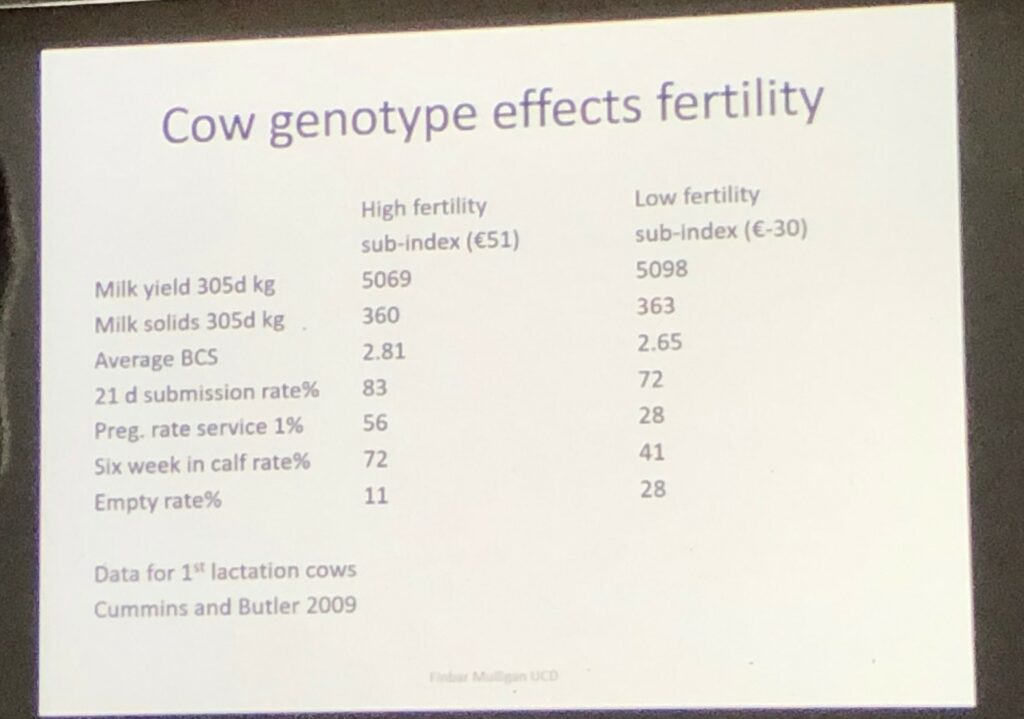“In the past, farmers were more interested in the milk yield of their cows than the fertility of their herd, but fertility is so important for the profitability of the dairy farm.”
This was a statement made by Dr. Finbar Mulligan at one of Alltech’s breeding seminars, where he outlined the key principles for successful breeding.
Speaking briefly on why good fertility is so important for the success of a dairy herd, he said: “The target six-week calving rate is 90%.
The reason that Teagasc thinks that this is an important target to achieve is because it believes that it costs about €8/cow for every percentage that you are below that target.
“In 2018, the national average calving down rate was 64%. The cost of this for a typical 100-cow herd equates to €21,000; and I believe that kind of a cost no problem.
“We all like other things about farming but at the end of the day it is profitability that is going to put the kids through college and it is obvious that good fertility is key to a farm’s profitability.
“But, their are many things that go into making a good fertility performance.”
1. Successful calving
First the cow must have a successful calving experience.
“Nearly all of the problems that can happen to a dairy cow with regard to herd health is going to happen to her around calving and many of these problems is a direct insult to achieving a good fertility performance.
“This (see below) is the days from calving to pregnancy for cows that are normal/healthy, have a low body condition score or for cows that have a retained faecal membrane, an endometritis or indeed a distocia/difficult calving.
“Dairy cows that have problems around calving are going to have a much more difficult time getting back in calf, so it very important that we manage the time around calving well.
I think that the three most important things about having a successful calving season, is body condition score, body condition score and body condition score. It is absolutely critical.
“How you achieve it at farm level can be done in a number of different ways. A lot of them are very successful, but the theory of controlled energy feeding for cows that have their condition score on target is a very sound theory,” expressed Finbar.
2. Nutrition in early lactation
“Nutrition in early lactation is very important because dairy cows have what you call a negative energy balance post-calving.
“Basically a cow’s energy requirements go up very quick after calving, but they have a very poor appetite so their energy ingested goes up very slowly.
“In the middle then, you have what you call unavoidable underfeeding. One thing to remember about this is it is not the same for every group of cows,” said Finbar.
Touching on what to do about this, he said: “What you want to do is minimise this unavoidable underfeeding as much as possible.
Prioistise the dry matter intake in early lactation and apologise to nobody for it. It is as simple as that.
“I believe that the majority of the underfeeding goes on when cows are in the shed in early lactation. We need to be realistic about the feeding levels and the feeding environment when cows are inside.
“And when you’re out grazing full time you have to remember the grass intakes that you are dealing with.
“If you are dealing with very low grass intakes, the requirement of feed will be significant. So, if you’re dealing with grass intakes of 10kg – which may be all that you have to offer – even with low yielding cows your going to need a high level of feed.
“Much higher than 3kg that you see advised. Sure enough the lads with low yielding cows can get by with very low levels of concentrates.
“But the point I’m making is that for high yielding cows, even with very good grass intakes, you still need a high level of concentrate supplementation,” highlighted Finbar.
3. Genetics
“We looked at the fertility performance of herds in the top, middle and bottom quartile for the EBI fertility sub-index.
“We found that their is a huge difference in terms of the percentage pregnant for those in the lowest quartile in comparison to the third quartile and the top quartile.
“So, if you are in the bottom quartile for fertility you really are going to be up against it to achieve a decent fertility performance.
“You don’t necessarily have to be in the highest quartile for fertility to achieve a decent fertility performance; but having a herd with a good fertility sub-index will make the job a lot easier,” explained Finbar.
4. Management
The management of your herd pre, during and even post-breeding is absolutely critical.
However, during breeding the most important “thing for fertility performance is heat detection”.
“What is the heat detection like on the farm? What was the heat detection like last year? How many heats were missed or was their many inaccurate heats recorded?
“By looking at the repeat interval you can tell what your heat detection is like. The normal repeat interval should be 18 to 21 days and you want more than 60% of repeats in that category.
If you have a lot in 0 to 17 days that is inaccurate heat detection and if you have a lot in 46 and 48 days that is inefficient heat detection.
“After 21 days breeding you need to have a plan for those not bred. Get the vet in scan them, see what’s going on and get them bred.
“If you’re using a bull he needs to be in good health, fertile and particularly with a young bull you need to watch to see if he is getting the job done,” concluded Finbar.



